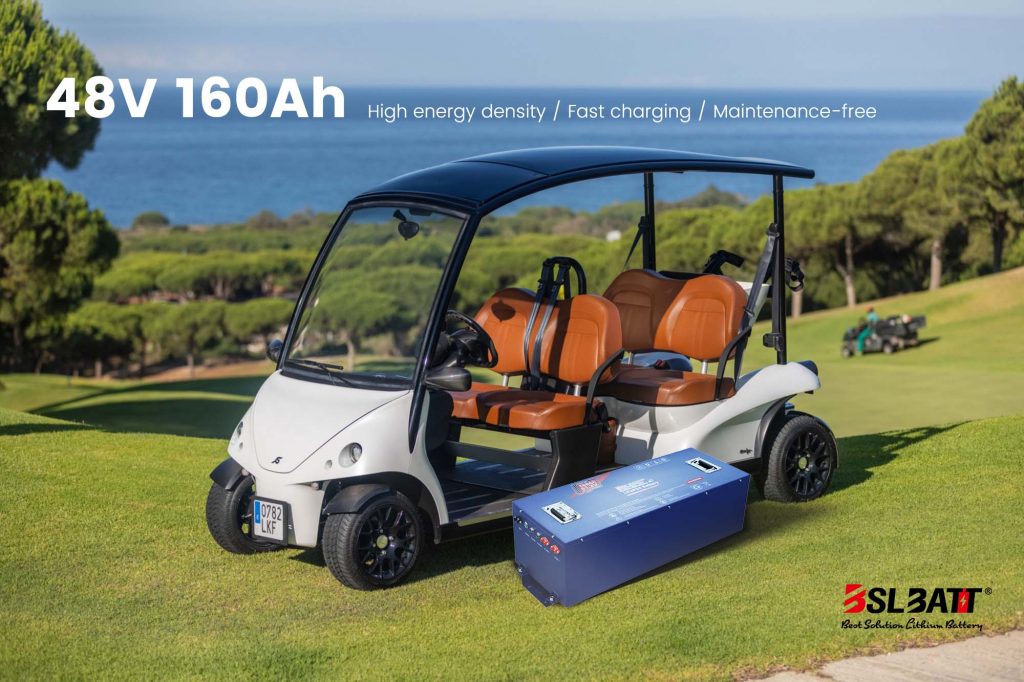Industry Application
Product Type
How Long Will Golf Cart Batteries Last?

The life of a golf battery is an important consideration for golf cart owners. Understanding how long a golf cart battery lasts can help you plan for maintenance and replacement, ensuring that your golf cart remains in optimal working condition. In this document, we will explore various aspects related to the longevity of golf cart batteries, including charging, power consumption, maximizing battery life, and the differences between lead acid and lithium batteries.
How Long Will Golf Cart Batteries Last?
The duration of golf cart battery life is contingent upon various factors, encompassing the battery type, frequency of usage and charging of the golf cart, as well as the battery’s upkeep and maintenance over time.
Lead-acid golf cart batteries typically endure for approximately two to five years under regular usage, whereas lithium-ion golf cart batteries, when properly maintained, may persist for ten to 20 years. In comparison, individually owned golf carts generally exhibit a longer lifespan of about six to ten years, whereas fleet vehicles utilized by multiple individuals throughout the day typically necessitate battery replacement after four to six years.
The different types of golf cart batteries
There exists a variety of golf cart batteries, each possessing its own advantages and disadvantages. One can acquire 6-volt, 8-volt, or 12-volt golf cart batteries to establish a 36- or 48-volt system. The utilization of 6-volt golf cart batteries generally enhances the duration of operation, although a greater quantity is required to meet the golf cart’s demands. Consequently, this can result in increased weight and installation complexities.
Furthermore, apart from selecting the appropriate power capacity, one can also opt for different types of golf cart batteries, including lead-acid, absorbed glass mat (AGM), gel lead-acid, or lithium-ion batteries. These batteries offer distinct benefits, with certain types performing better in extreme weather conditions, while others provide a lengthier lifespan.
Golf Cart Lead-Acid Batteries
Lead-acid batteries are widely recognized as one of the most prevalent battery variants utilized in golf carts. These conventional batteries possess the advantage of being the most cost-effective alternative and require minimal effort to upkeep. However, they do exhibit a tendency to possess a shorter lifespan compared to more sophisticated golf cart battery types, typically enduring for a mere two to five years. Additionally, the weight of lead-acid golf cart batteries is considerable, rendering it an unfavorable characteristic for a vehicle of such diminutive proportions.
Battery for golf carts with Absorbed Glass Mat (AGM)
AGM batteries are equipped with absorbable electrolyte and fiberglass plates, enabling them to charge up to five times faster than conventional lead-acid batteries. Additionally, they offer protection against leaks that can cause corrosion and reduce battery lifespan. These batteries require minimal maintenance and can last up to six or seven years. However, it should be noted that they are a more costly option, which can result in significant expenses when servicing a fleet of golf carts.
A golf cart battery that uses gel lead-acid
As its name suggests, a gel lead-acid battery employs a gel to suspend the electrolyte within the battery. The gel medium facilitates the flow of electrons from plate to plate, ensuring leak-proof protection and minimal maintenance. Moreover, this design confers upon this variant of golf cart battery the ability to withstand extreme temperatures, particularly cold weather, which can curtail the lifespan of most golf cart batteries. However, it is worth noting that these batteries do not offer the rapid charging capabilities of AGMs.
Using lithium-ion batteries in golf carts
Lithium-ion golf cart batteries, despite their higher initial cost, are a prudent investment in the long term due to their compactness and lightness. These batteries are renowned for their longevity, with a lifespan of up to 20 years when properly maintained, and over 10 years on average.
Furthermore, lithium-ion batteries require minimal upkeep as they do not necessitate the addition of water. Unlike other golf cart batteries, self-discharge is not a significant concern with golf cart lithium ion battery, as they possess a low self-discharge rate that enables them to remain idle for extended periods without losing power.

Factors Affecting Golf Cart Battery Life
When it comes to charging golf cart batteries, it is crucial to follow the manufacturer’s guidelines. Proper charging techniques can significantly extend the lifespan of the battery. Most modern golf cart batteries require regular charging to maintain their performance. It is recommended to charge your golf cart battery after each use, especially if you have been playing for an extended period.
Power consumption is another factor that affects the lifespan of a golf cart battery. The more often and heavily you use your golf cart, the faster the battery will drain. Driving up steep inclines, carrying heavy loads, or using accessories that draw significant power can all contribute to increased power consumption. To maximize battery life, it is advisable to avoid overworking the battery and to be mindful of power usage.
Ways to extend battery life
To get the most out of your golf cart battery, there are a few steps you can take. Regularly inspecting and cleaning the battery terminals can help ensure a good connection and prevent corrosion. Additionally, keeping the battery properly watered, if it is a lead acid battery, and storing it in a cool, dry place when not in use can help prolong its lifespan.
Over time, golf cart batteries will eventually need to be replaced. Signs that your battery may need replacement include a noticeable decrease in performance, reduced driving range, or difficulty holding a charge. If you encounter any of these issues, it is recommended to have your battery tested by a professional to determine if replacement is necessary.

The 5 signs you need to replace your golf cart battery
If you suspect that your battery is failing, it is advisable to be vigilant for the following indicators that necessitate a replacement of your golf cart battery. It is crucial to address this matter promptly to avoid being stranded with a completely depleted battery.
Charging takes a long time
As time progresses, the charging duration of your golf cart batteries is expected to gradually increase. It may become apparent that the battery requires several additional hours to recharge in comparison to its usual time frame, or even an entire day before it becomes ready for use on the golf course. Should the battery’s recharging time exceed 8 to 10 hours, it is highly probable that it is approaching the conclusion of its operational lifespan.
A slow acceleration rate
When the gas pedal is depressed, the anticipation is for the golf cart to initiate motion. However, if the golf cart encounters difficulty in accelerating when the gas pedal is pressed, it may indicate the presence of a deteriorating battery. Additionally, one may observe that the golf cart experiences heightened challenges in traversing hills compared to its usual performance.
Travel distances are shorter
Previously, your golf cart had the ability to travel several miles in a day before necessitating a recharge. However, presently, it can only cover a distance of one or two miles before experiencing a power loss or the battery’s lifespan between charges has significantly reduced. This serves as an additional indication that a replacement of the golf cart battery is necessary. The battery should possess sufficient strength to enable the golf cart to navigate a golf course for a few rounds of golf at the very least.
Discrepancies
Upon driving the golf cart away from the storage area, it becomes apparent that a puddle has been left behind. This occurrence may indicate a potential battery leak in the lead-acid batteries. It is crucial to acknowledge that lead-acid batteries have the capability to release toxic chemicals, which can pose harm to both individuals, their belongings, and the surrounding environment. In the event of a leaking battery, it is imperative to promptly address the situation by undertaking the necessary measures to clean up the leak and promptly replace the battery. This proactive approach is essential in order to prevent any further damage from occurring.
Batteries with visible damage
In addition to a battery experiencing leakage, there exist numerous other observable indications of battery damage. Such damage may manifest as corrosion, cracks, or bulges in the battery. Corrosion, in particular, can lead to additional and costlier harm, such as the release of terminals or the cracking of the battery casing.
The process of recharging batteries can generate heat, which gradually results in the bulging of the batteries. The presence of visible damage, including corrosion, cracks, or bulges, serves as prevalent indicators of an aged and depleted battery.

Maintaining golf cart batteries
Regardless of the type of battery used to power your golf carts, be it lead-acid, AGMs, gel lead or lithium-ion, the quality of the equipment is solely dependent on the level of attention and care it receives. Adequate maintenance and care can significantly extend the lifespan of your golf cart battery, from a few years to nearly a decade. Therefore, it is imperative to provide your golf cart battery with the necessary tender loving care it deserves.
Don’t overcharge
When the golf cart fleet requires recharging, it is imperative to limit the charging duration to approximately 8 to 10 hours. Excessive charging can result in detrimental effects on the battery cells, potentially leading to battery dehydration and necessitating more frequent water refills. It is advisable to cease charging once the battery reaches its full capacity, rather than leaving the golf cart continuously connected to the charger during periods of non-use.
Make sure your batteries don’t die
It is imperative to strike a balance between avoiding overcharging and preventing the batteries of your golf cart from completely discharging. It is recommended to maintain the battery charge level at a minimum of 50% and never allow it to drop below 20%. The battery manufacturer will provide the optimal charging limits, and it is crucial to adhere closely to their instructions in order to extend the lifespan of your battery.
Warm places are best for storing carts
With the exception of gel batteries, the majority of golf cart batteries do not fare well in cold weather conditions. The battery’s capacity can be significantly reduced by cold temperatures. It is advisable to store the carts in a heated garage or an alternative storage area, and to refrain from operating them in extreme temperatures. To maintain the battery’s charge during colder months without risking overcharging, a trickle charger can be utilized.
Battery strain is minimized
Although it may provide amusement to traverse golf carts across elevated terrain on the course or premises, it is advisable to adhere to level and direct pathways whenever feasible. Ascending hills necessitates increased power consumption from the battery, and engaging in this activity frequently can expedite battery deterioration.
Regularly inspect batteries
If you want your batteries to last longer, regular inspections will help you catch any problems early. First, you’ll want to check lead-acid batteries once per month and keep the water at the fill line. For batteries that don’t need water, inspect the batteries for visible damage and test the voltage about once every couple of months.
Golf Cart Batteries: Find the Right One
The lifespan of a golf cart battery is contingent upon numerous factors; however, one can extend its longevity through consistent maintenance practices and selecting the most suitable battery that aligns with their requirements, regardless of whether it is intended to power a few golf carts or a substantial fleet.
Learn more
the differences between lead acid and lithium batteries
Lead acid batteries have been the traditional choice for golf carts due to their affordability. However, they require regular maintenance and have a limited lifespan compared to lithium batteries. Lead acid batteries need to be periodically topped up with distilled water and may require equalization charges to maintain their performance. Despite these drawbacks, lead acid batteries are still commonly used in many golf carts.
Lithium golf cart batteries, on the other hand, offer several advantages over lead acid batteries. They are lightweight, have a longer lifespan, and require less maintenance. Lithium batteries also provide consistent power throughout their entire discharge cycle, resulting in improved performance and a longer driving range. Although lithium batteries are typically more expensive upfront, their long-term benefits often outweigh the initial cost.
In conclusion
The lifespan of a golf cart battery depends on various factors, including charging practices, power consumption, and maintenance. By following proper charging techniques, being mindful of power usage, and taking care of your battery, you can prolong its lifespan. Additionally, considering the advantages of lithium batteries over lead acid batteries may be a worthwhile investment to enhance your golf cart’s performance and longevity. If you have any help, please contact us
A Guide to Choosing the Best 48V Lithium Golf Cart Battery
Would it be worth investing in a 48V ...
10 Exciting Ways To Use Your 12V Lithium Batteries
Back in 2016 when BSLBATT first began designing what would become the first drop-in replacemen...
BSLBATT Battery Company Receives Bulk Orders from North American Customers
BSLBATT®, a China Forklift battery manufacturer specializing in the material handling indust...
Fun Find Friday: BSLBATT Battery is coming to another great LogiMAT 2022
MEET US! VETTER’S EXHIBITION YEAR 2022! LogiMAT in Stuttgart: SMART – SUSTAINABLE – SAF...
Looking for new Distributors and Dealers for BSL Lithium Batteries
BSLBATT battery is a fast-paced, high-growth (200% YoY ) hi-tech company that is leading the a...
BSLBATT to Participate at MODEX 2022 on March 28-31 in Atlanta, GA
BSLBATT is one of the largest developers, manufacturers, and integrators of lithium-ion batter...
What makes the BSLBATT the Superior Lithium Battery for your Motive Power needs?
Electric forklift and Floor Cleaning Machines owners who seek the ultimate performance will fi...





























